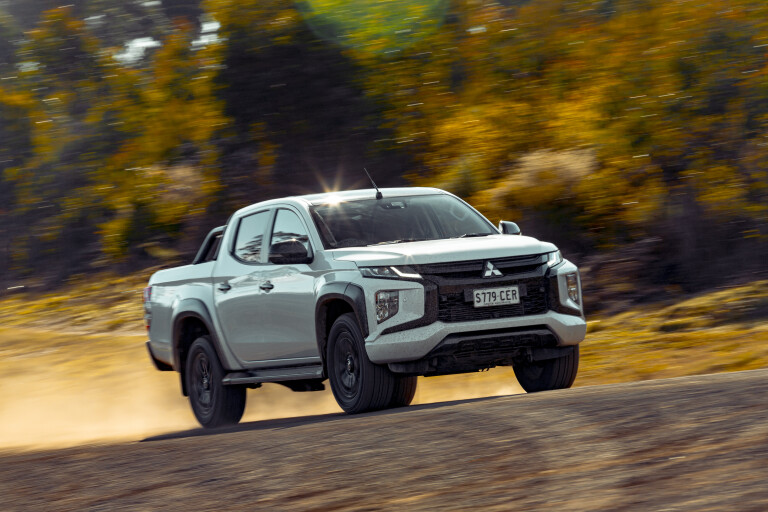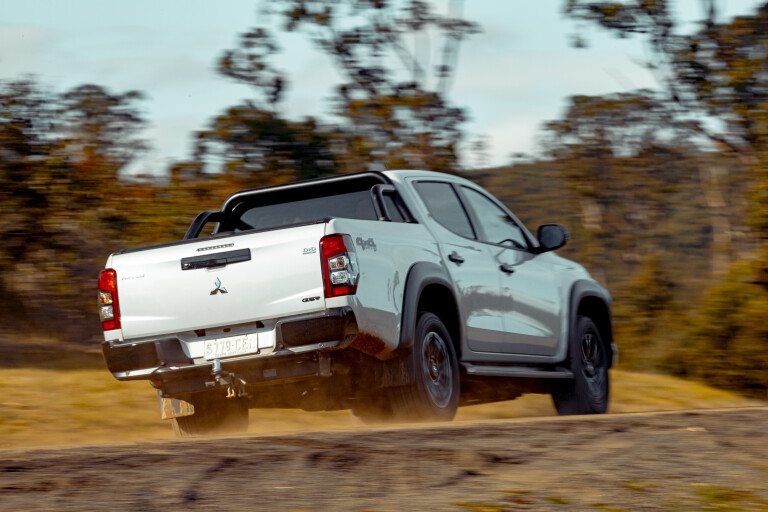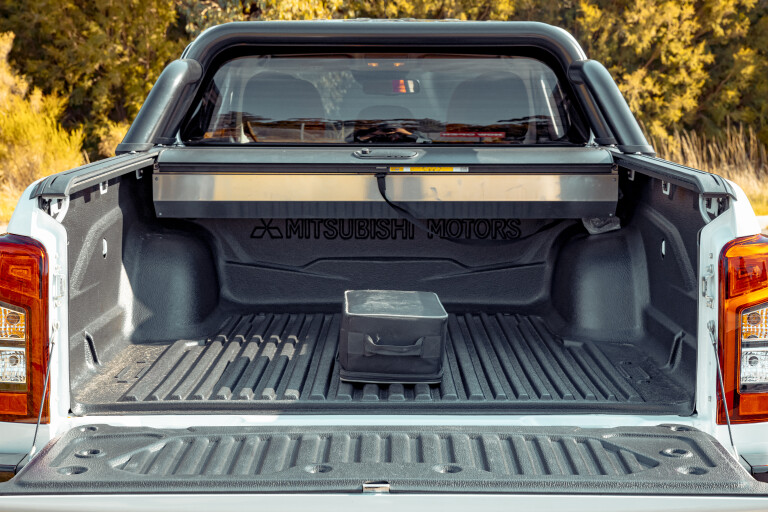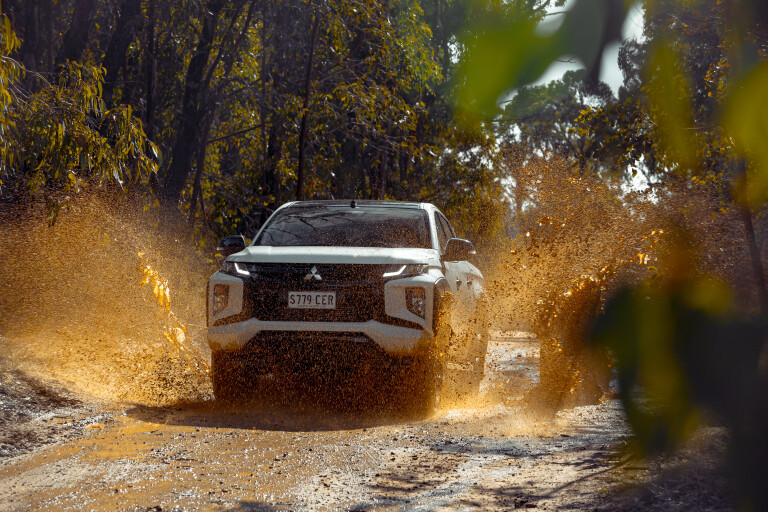
Score breakdown
Things we like
- Loaded with equipment
- Impressive off-road capability
- Industry-leading warranty
Not so much
- No stand-out attributes
- Firm, jiggly ride
- Roller tonneau hurts practicality
It’s the age-old question: do you buy the top-spec of a cheaper model or go for the more expensive option and settle for a variant further down the food chain? If you’re looking at the Mitsubishi Triton GSR you’ve probably opted for option A.
Whereas the top-spec Toyota Hilux and Ford Ranger are north of $70,000 by the time they come off the showroom floor, this flagship Triton is $57,240 drive-away (a figure that will adjust slightly depending on your state or territory).
It comes loaded with all the bells and whistles: keyless entry and go, leather seats (the fronts heated and driver’s side electrically adjustable), six-speaker stereo, 7.0-inch infotainment touchscreen with digital radio and smartphone mirroring, dual-zone climate control, rearview camera, front and rear parking sensors, auto wipers and headlights and more.

In terms of safety, you score front, front-side and curtain airbags with another for the driver’s knee, as well as a comprehensive suite of active safety systems, including auto emergency braking, lane departure warning, lane-keep assist, blind-spot warning and trailer stability assist.
Distinguishing the GSR externally from its lesser siblings are black exterior highlights, including grille, wheels, roof, mirrors and door handles, as well as a sports bar and hard-top roller tonneau. The latter has its pros and cons: while the lockable tray cover is handy for security, its storage cartridge robs significant tray space and forces the tie-down points rearward, making securing loads more difficult.
On that side of things, the tray is 1520 x 1470 x 475mm (length/width/depth) with 1085mm between the wheelarches, though these measurements don’t account for the roller-top storage cartridge. Maximum payload is 900kg and maximum towing capacity is 3100kg, though with a 5885kg Gross Combination Mass, the payload when towing that amount is limited to 785kg.

Mitsubishi's popular dual-cab does little wrong, but nor does it stand out in any area
Historically, the GSR badge was applied to hot Lancers but while the Triton is both turbocharged and all-wheel drive it makes do with the same 133kW/430Nm 2.4-litre four-cylinder diesel as every other variant.
It’s an effective rather than inspiring engine. We tested the GLS version recently at a leisurely 11.36sec from 0-100km/h but its performance improves on the move. Throttle response is efficient and there’s a solid hit of low- to mid-range torque but it’s a noisy operator and the powerband is a narrow one.
The six-speed automatic doesn’t require a second thought, though the related Pajero Sport’s eight-speeder makes better use of the engine’s limited reserves. You can always take charge manually via the snazzy paddles that have been lifted from the final generation Lancer Evolution; some may deem them frivolous, but they’re a welcome bit of theatre.

Up front, the seats are well-bolstered and comfortable though perhaps set a little high, and the tan leather that’s been liberally applied throughout the GSR’s interior will be an acquired taste. It’s a cabin that favours function over form, which isn’t a criticism in this segment, especially when function includes touches like a reach- and rake-adjustable steering column.
A larger infotainment screen would be nice (the Navara and Ranger are 8.0-inch, the D-Max/BT-50 9.0-inch). A pair of USB ports handle smartphone mirroring and charging duties along with an HDMI input and two central cupholders, while the door bins can accommodate 1.5L bottles.
The rear bench is quite comfy, albeit a little short on under-thigh support, but rear occupants aren’t neglected with roof-mounted air vents and separate fan control, reading lights, a pair of USB ports, a storage cubby hole in the back of the centre console, two cupholders in the fold-down centre armrest and similarly large door bins.

On the road, the Triton’s relatively compact dimensions – it’s a lengthy 5.3m but just over 1.8m wide – aid urban manoeuvring, but the slow steering requires plenty of twirling and the ride never settles, continually fidgeting over road imperfections. The firmer suspension actually improves matters off-road, however, with greater body control than some of its competitors.
Higher-spec Tritons, including the GSR, also benefit from Mitsubishi’s Super Select all-wheel-drive system, which allows it to operate in rear- or all-wheel drive, even on tarmac, thanks to its centre differential. That diff can also be locked in high- or low-range in the rough stuff and there’s a rear differential lock as well.
There are also separate modes for rock, gravel, mud/snow and sand. Super Select can take quite a long time to switch between 4-High and 4-Low, with a number of back-and-forth operations required for it to figure out what’s going on. Nevertheless, even on road-biased tyres the Triton is impressively capable, though check out 4x4 Australia’s review for a more off-road-oriented take.

All in all, Mitsubishi’s popular dual-cab doesn’t do much wrong, but nor does it really stand out from the pack in any area except one – value. This is where the Triton wins and the GSR loses. While this range-topper certain packs plenty in for its $57K-odd ask, that price tag is getting uncomfortably close to the likes of the Ford Ranger XLT Bi-Turbo ($60,490DA) and Isuzu D-Max X-Terrain ($59,990DA), a pair of utes that finished 1-2 in our recent dual-cab mega test.
We’d sneak a bit further down the range into the GLS, which virtually matches the GSR on spec but is substantially cheaper at $48,290DA, or, if you can live without a few toys, the $43,690DA GLX+. Here the Triton virtually has the market to itself, offering capability that the challenger brands (Ssangyong Musso, GWM Ute) struggle to match but at a price that doesn’t even get you in the door of a Navara, D-Max, Ranger or Hilux.
What you’re left with is a simple, rugged and capable ute with the peace of mind of a 10-year warranty.

2021 Mitsubishi Triton GSR specifications
| Body: | 5-door, 5-seat ute |
|---|---|
| Drive: | rear-/all-wheel drive |
| Engine: | 2442cc inline-4cyl diesel, DOHC, 16v, turbo |
| Bore/stroke: | 86.0 x 105.1mm |
| Compression: | 15.5:1 |
| Power: | 133kW @ 3500rpm |
| Torque: | 430Nm @ 2500rpm |
| Fuel consumption: | 8.6L/100km (combined/claimed) |
| Weight: | 1999kg |
| GVM: | 2900kg |
| Power/weight: | 66.5kW/tonne |
| Transmission: | 6-speed automatic |
| Suspension: | double wishbones, coil springs, anti-roll bar (f); leaf springs (r) |
| L/W/H: | 5305/1815/1795mm |
| Wheelbase: | 3000mm |
| Ground clearance: | 220mm (unladen) |
| Steering: | hydraulically assisted rack-and-pinion |
| Brakes: | 320mm ventilated discs, single-piston calipers (f); 295mm drums (r) |
| Wheels: | 18 x 7.5-inch (f/r) |
| Tyres: | 265/60 R18 110H (f/r); Dunlop Grandtrek AT20 |
| Price: | $57,240DA |
Score breakdown
Things we like
- Loaded with equipment
- Impressive off-road capability
- Industry-leading warranty
Not so much
- No stand-out attributes
- Firm, jiggly ride
- Roller tonneau hurts practicality

COMMENTS